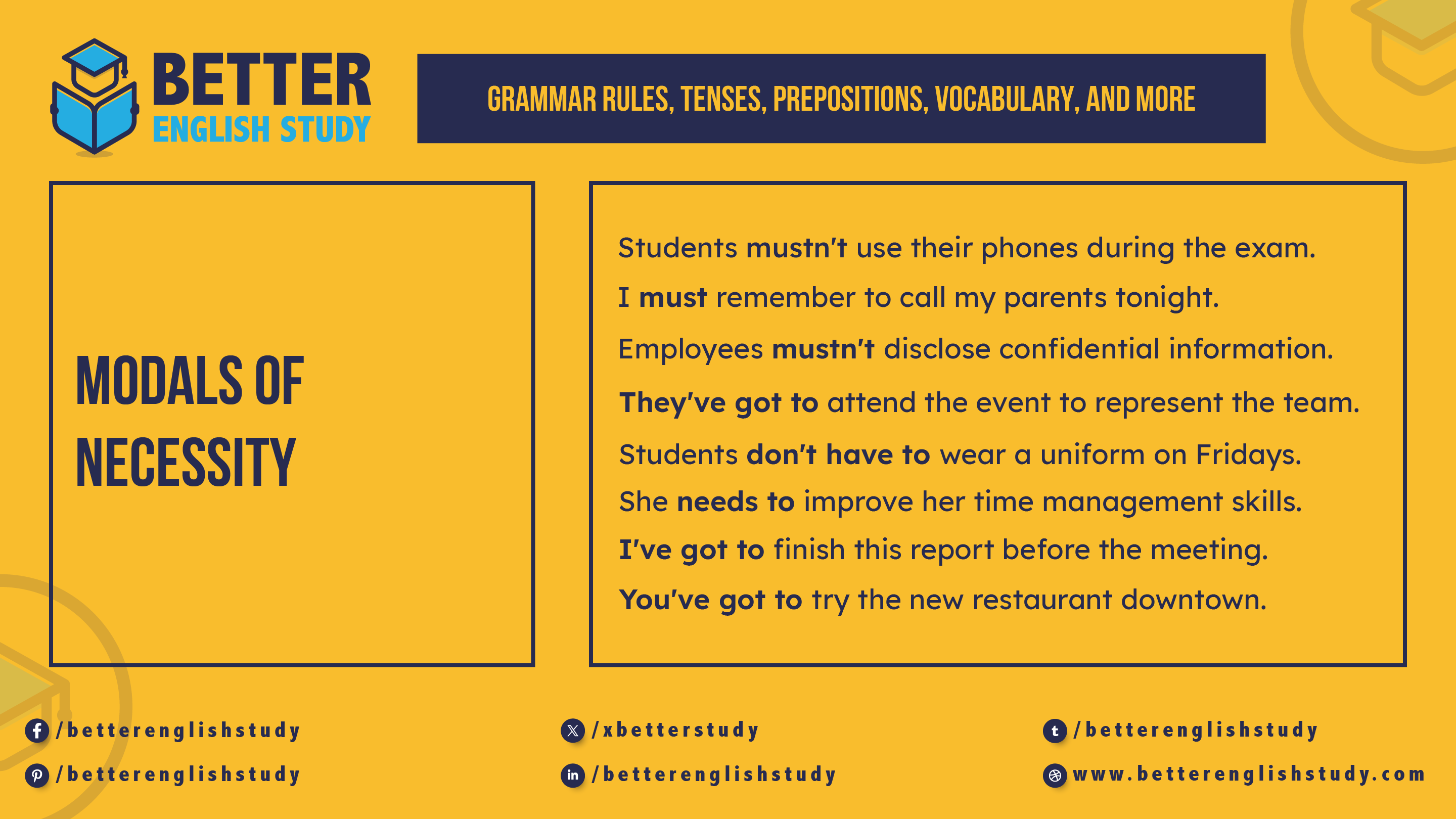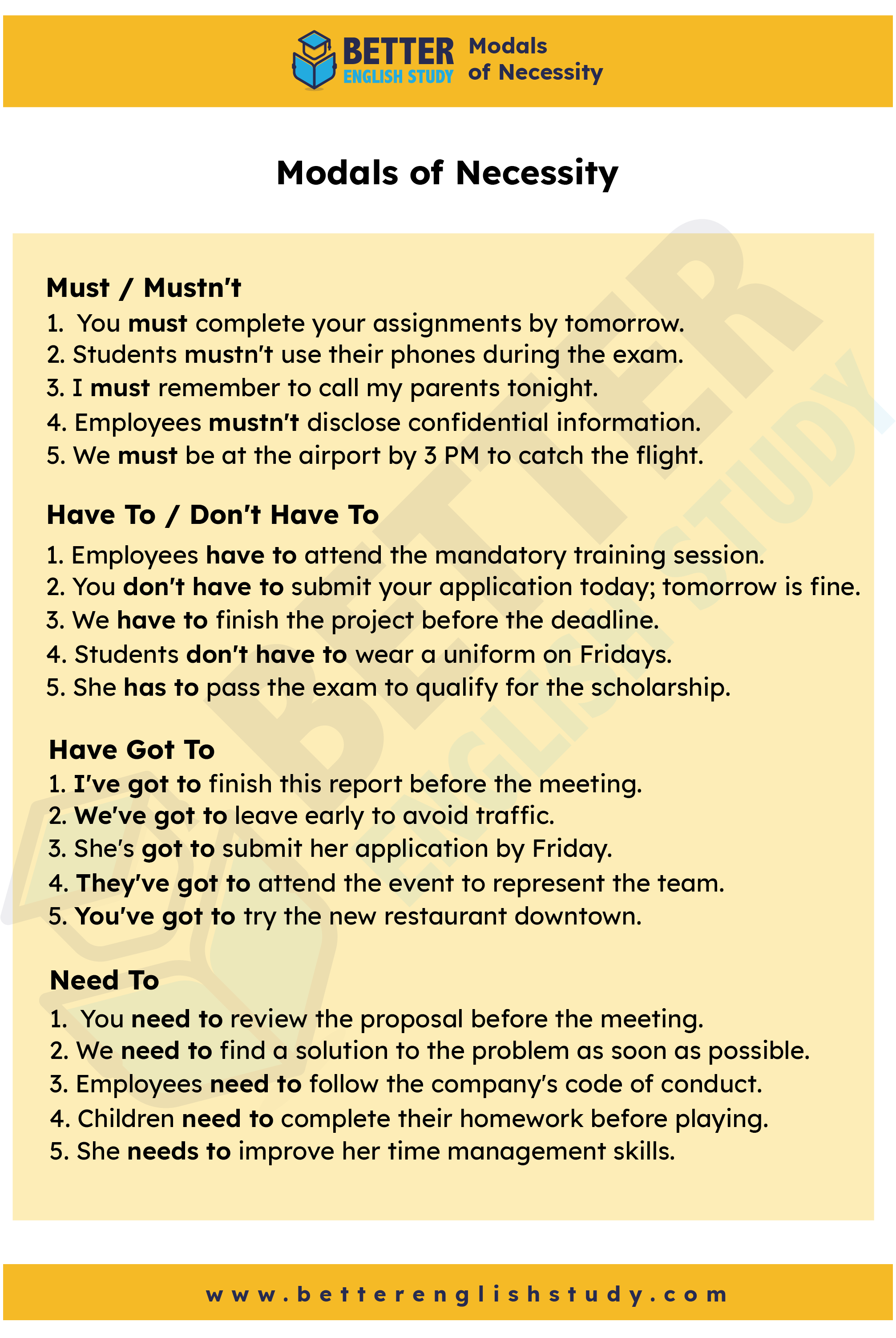
In the intricate tapestry of English grammar, modals serve as indispensable threads, weaving meaning, and nuance into our expressions. When it comes to conveying necessity, modals play a pivotal role in articulating obligations, requirements, and essential actions.
In this exploration, we will delve into modals of necessity—’must’ and ‘mustn’t,’ ‘have to’ and ‘don’t have to,’ ‘need to,’ and ‘have got to’—unveiling the distinct shades of meaning each brings to expressions of obligation.
Meaning of Necessity in Language
Before we unravel the specifics of each modal, let’s establish a foundational understanding of necessity in language. Necessity refers to the essential nature of an action, obligation, or requirement imposed by circumstances or external factors. Modals of necessity equip us with the linguistic tools to navigate these requirements with precision.
Exploring Modals of Necessity
Each modal in the category of necessity serves a unique purpose in conveying obligations, mandates, or requirements.
Let’s explore the nuances of ‘must’ and ‘mustn’t,’ ‘have to’ and ‘don’t have to,’ ‘need to,’ and ‘have got to.’
Must / Mustn’t
‘Must’ and ‘mustn’t’ are modals that convey a sense of strong necessity or prohibition. ‘Must’ is the most forceful and serious, primarily employed in written language. Using ‘must’ in questions is uncommon.”
Examples:
- You must complete your assignments by tomorrow.
‘Must’ here indicates a strong obligation to finish assignments by the specified time.
- Students mustn’t use their phones during the exam.
‘Mustn’t’ conveys a strict prohibition against using phones in the exam.
- I must remember to call my parents tonight.
In this context, ‘must’ implies a personal obligation to make a phone call.
- Employees mustn’t disclose confidential information.
‘Mustn’t’ here expresses a clear prohibition against sharing confidential details.
- We must be at the airport by 3 PM to catch the flight.
‘Must’ denotes a strong necessity to be at the airport on time.
Have To / Don’t Have To
‘Have to’ and ‘don’t have to’ express necessity but with a slightly different shade compared to ‘must.’
Examples:
- Employees have to attend the mandatory training session.
‘Have to’ conveys a requirement for employees to attend the training.
- You don’t have to submit your application today; tomorrow is fine.
‘Don’t have to’ indicates the absence of a strict requirement to submit the application today.
- We have to finish the project before the deadline.
In this context, ‘have to’ emphasizes the necessity of completing the project on time.
- Students don’t have to wear a uniform on Fridays.
‘Don’t have to’ conveys the absence of an obligation for students to wear uniforms on Fridays.
- She has to pass the exam to qualify for the scholarship.
‘Has to’ emphasizes the necessity of passing the exam for scholarship eligibility.
Need To
‘Need to’ is a versatile modal indicating necessity or requirement in a more general sense.
Examples:
- You need to review the proposal before the meeting.
‘Need to’ suggests a general necessity for reviewing the proposal before the meeting.
- We need to find a solution to the problem as soon as possible.
In this context, ‘need to’ emphasizes the urgency of finding a solution.
- Employees need to follow the company’s code of conduct.
‘Need to’ conveys the general requirement for employees to adhere to the code of conduct.
- Children need to complete their homework before playing.
‘Need to’ here expresses a standard requirement for children to finish homework before engaging in play.
- She needs to improve her time management skills.
‘Needs to’ indicates a necessary improvement in time management skills.

Have Got To
‘Have got to’ is an informal modal emphasizing a strong obligation or necessity.
Examples:
- I’ve got to finish this report before the meeting.
‘Have got to’ expresses a strong obligation to complete the report before the meeting.
- We’ve got to leave early to avoid traffic.
In this context, ‘have got to’ emphasizes the strong necessity of leaving early.
- She’s got to submit her application by Friday.
‘Has got to’ indicates the strong obligation to submit the application by the specified time.
- They’ve got to attend the event to represent the team.
‘Have got to’ conveys the strong necessity for their attendance to represent the team.
- You’ve got to try the new restaurant downtown.
‘Have got to’ here suggests a strong recommendation or a persuasive expression of necessity.
Navigating Necessity with Modals – Rules to Remember
When using modals of necessity, consider the following rules to ensure accurate and effective communication:
- Specificity: ‘Must’ and ‘mustn’t’ often convey a stronger sense of obligation compared to ‘have to’ and ‘don’t have to.’
- Flexibility: ‘Have to’ and ‘need to’ provide a slightly more flexible approach to expressing necessity.
- Informality: ‘Have got to’ is more informal and often used in spoken language to emphasize a strong obligation.
- Negation: The negative forms ‘mustn’t’ and ‘don’t have to’ convey prohibition and lack of obligation, respectively.
In the intricate landscape of necessity, modals like ‘must,’ ‘have to,’ ‘need to,’ and ‘have got to’ serve as indispensable tools, allowing us to articulate obligations with precision. By understanding the nuances of each modal, language learners can easily navigate the complex web of requirements and mandates.
So, whether it’s a strict mandate or a flexible necessity, these modals empower us to express the essential nature of actions in English, ensuring clear and effective communication in various contexts.
As you integrate these modals into your language repertoire, you’ll find yourself equipped to navigate the diverse terrain of linguistic necessity with confidence and accuracy.
